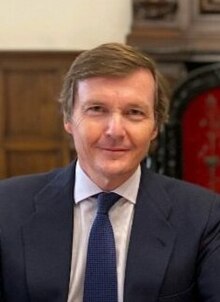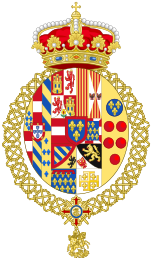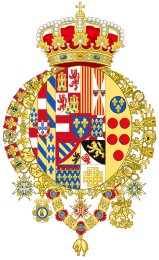Duke of Calabria
| Prince Pedro | |||||
|---|---|---|---|---|---|
| Duke of Calabria Count of Caserta | |||||
 | |||||
| Head of the House of Bourbon-Two Sicilies (disputed) | |||||
| Tenure | 5 October 2015 – present | ||||
| Predecessor | Infante Carlos | ||||
| Heir | Prince Jaime | ||||
| Born | (1968-10-16) 16 October 1968 (age 56) Madrid, Spain | ||||
| Spouse |
Sofía Landaluce y Melgarejo
(m. 2001) | ||||
| Issue | Prince Jaime, Duke of Noto Prince Juan Prince Pablo Prince Pedro Princess Sofía Princess Blanca Princess María | ||||
| |||||
| House | Bourbon-Two Sicilies | ||||
| Father | Infante Carlos, Duke of Calabria | ||||
| Mother | Princess Anne of Orléans | ||||
| Religion | Roman Catholic | ||||
| Sicilian royal family |
|---|
 |
Extended royal family
|
Prince Pedro of Bourbon-Two Sicilies, Duke of Calabria, Grandee of Spain (Spanish: Pedro Juan María Alejo Saturnino de Todos los Santos; born 16 October 1968), is the only son of Infante Carlos, Duke of Calabria (1938–2015), and his wife, Princess Anne of Orléans. As primogeniture heir of the kings of the Two Sicilies he is the principal claimant to the headship of the Royal House of Bourbon-Two Sicilies, which ruled the Kingdom of the Two Sicilies before the unification of Italy.
Claim
He is the only son of Infante Carlos, Duke of Calabria (1938–2015), and his wife, Princess Anne of Orléans. Pedro is the senior of the two claimants to the headship of the House of Bourbon-Two Sicilies, since the death of his father on 5 October 2015. The other claimant is Prince Carlo, Duke of Castro. Pedro is claimant to the grand mastership of the Constantinian Order, and the grand mastership of the Order of Saint Januarius, as well as president of the Council of the four Spanish Military Orders of Santiago, Calatrava, Alcántara and Montesa, and grand commander of the Order of Alcántara. He is also a grandee of Spain, as the son of an infante of Spain.
Act of Cannes (1900)
On 14 December 1900, Prince Carlos, next oldest brother to the childless Prince Ferdinand, head of the House of Bourbon-Two Sicilies and immediate heir of their father, claimant to the former throne of the Two Sicilies, signed a private agreement purporting to renounce the "future succession" to the former crown before his marriage to María de las Mercedes, Princess of Asturias, heiress presumptive to the throne of Spain. The Spanish minister of Justice had stated in the Cortes (Parliament) on 18 December 1900 that no renunciation was necessary and any such renunciation would be null and void. This document, known as the Act of Cannes, was signed in purported obedience to the 1759 Pragmatic Sanction signed by Charles III of Spain where it was established that the thrones of Spain and Naples should never be united in the person of the same monarch, separating them forever to preserve the European balance of power. The newly independent Kingdom of Naples was ceded by Charles III of Spain to his third child, who would become Ferdinand I of Naples. This would establish the kings of Naples and Sicily as cadet members of the Spanish royal family, and so the country enjoyed strong relationships with its 'mother state', following many of its legal customs. The Act of Cannes states:
Before Us, Don Alfonso de Borbón, Count of Caserta... Head of the Royal House and Dynasty of the Two Sicilies... His Royal Highness Prince Don Carlos, our beloved Son, appears and declares that, preparing to marry HRH Infanta María de las Mercedes, Princess of Asturias, and assuming by such marriage the nationality and quality of Spanish Prince, undertakes to renounce by this Act and solemnly renounces, for himself and for his heirs and successors, all the right and reason to the eventual succession to the Crown of the Two Sicilies and to all the assets of the Royal House that are in Italy and elsewhere, and this according to our Laws, constitutions and Family customs, in execution of the Pragmatic Sanction of King Charles III, our Augustus ancestor, of October 6, 1759, the prescriptions of which he freely and spontaneously declares to subscribe and obey. He also declares, in particular, to renounce for himself, his heirs and successors to the assets and values existing in Italy, Vienna and Monaco (Bavaria) and destined by His Majesty King Francis II (may God have welcomed his soul), to the foundation of a majorat for the Head of the Dynasty and of the Family of the Two Sicilies and for the constitution of an endowment fund in favor of the Royal Princesses and granddaughters of our August Father King Ferdinand (may God have welcomed his soul), of marriageable age; but preserving his rights to the part of the assets that were bequeathed to him by his late uncle King Francis II, in the event that the Italian Government, which improperly retains them, makes the due restitution and the same everything that may arrive to him by other testamentary legacies.
— Cannes, 14 December 1900
Supporters of the other claimant to the headship of the House of Bourbon-Two Sicilies, sometimes referred to as the Castrist faction, argue that because Prince Carlos signed this agreement, he relinquished all of his rights and those of his descendants to both the headship of the family and the Sacred Military Constantinian Order of Saint George, and so the rights currently fall on Prince Carlo, Duke of Castro. However, supporters of Pedro, also known as the legitimists, argue that the Act of Cannes was subject to a condition that never arose and it ls terms would have only applied if Prince Carlo's wife had inherited the throne of Spain, and he had become king of the Two Sicilies, which never happened and was furthermore highly unlikely at the time the document was created. The legitimist supporters also point out several flaws in the document and its interpretation and that it was subordinate to the Pragmatic Decree and laws of the House. Also, they argue that the Act of Cannes never mentioned the headship of the House of Bourbon-Two Sicilies nor the grand mastership of the Constantinian Order, and so this was therefore never renounced. Regardless, the Papal Brief of 1698 and Bull of 1718 established that the grand mastership was not tied to any temporal sovereignty but was a separate inheritance of the Farnese family, and so it is the mainstream academic view that succession is not linked to the throne of Naples and Sicily. Following this logic, at the very least, the headship and grand magistry of the Constantinian Order would fall on Prince Pedro. In due course, Prince Carlo inherited his share of properties of the royal family in Italy, despite the purported renunciation, with no objection by his brothers and sisters.
Career
He graduated as an agricultural engineer from the University of Castilla-La Mancha, and completed his Spanish military service in the Royal Guard. He manages the family estate, La Toledana in Ciudad Real, Spain, as well as other landed estates in Spain and Austria.
Marriage and issue
Pedro married Sofía Landaluce y Melgarejo (born 23 November 1973 in Madrid), daughter of José Manuel Landaluce y Domínguez and his wife María de las Nieves Blanca Melgarejo y González (granddaughter of the Dukes of San Fernando de Quiroga), on 30 March 2001 at Real Club de la Puerta de Hierro in Madrid. Pedro and Sofía have seven children:
- Prince Jaime of Bourbon-Two Sicilies (born 26 June 1992 in Madrid), Duke of Noto (Duke of Capua 2012–2015), Grand Constable of the Order of Saint George of the Reunion, Grand Prefect of the Constantinian Order, Knight of Alcántara, Knight of Honour and Devotion of the Sovereign Military Order of Malta. Married to Lady Charlotte Diana Lindesay-Bethune (born 12 May 1993), youngest child of Scottish businessman and politician James Lindesay-Bethune, 16th Earl of Lindsay, and his wife, Diana Mary Chamberlayne-Macdonald, on 25 September 2021 at Monreale Cathedral. They have one daughter:
- Princess Francesca Sofía of Bourbon-Two Sicilies (born 13 October 2023 in London)
- Prince Juan of Bourbon-Two Sicilies (born 18 April 2003 in Madrid)
- Prince Pablo of Bourbon-Two Sicilies (born 26 June 2004 in Madrid)
- Prince Pedro of Bourbon-Two Sicilies (born 3 January 2007 in Ciudad Real)
- Princess Sofía of Bourbon-Two Sicilies (born 12 November 2008 in Madrid)
- Princess Blanca of Bourbon-Two Sicilies (born 7 April 2011 in Ciudad Real)
- Princess María of Bourbon-Two Sicilies (born 5 March 2015 in Ciudad Real)
Honours
Dynastic
 : House of Bourbon-Two Sicilies: Knight Grand Cross of Justice of the Sacred Military Constantinian Order of Saint George (1986–2015)
: House of Bourbon-Two Sicilies: Knight Grand Cross of Justice of the Sacred Military Constantinian Order of Saint George (1986–2015) : House of Bourbon-Two Sicilies: Sovereign and Grand Master of the Illustrious Royal Order of Saint Januarius
: House of Bourbon-Two Sicilies: Sovereign and Grand Master of the Illustrious Royal Order of Saint Januarius : House of Bourbon-Two Sicilies: Sovereign and Grand Master of the Sacred Military Constantinian Order of Saint George
: House of Bourbon-Two Sicilies: Sovereign and Grand Master of the Sacred Military Constantinian Order of Saint George : House of Bourbon-Two Sicilies: Sovereign and Grand Master of the Order of Saint Ferdinand and of Merit
: House of Bourbon-Two Sicilies: Sovereign and Grand Master of the Order of Saint Ferdinand and of Merit : House of Bourbon-Two Sicilies: Sovereign and Grand Master of the Royal Order of the Two-Sicilies
: House of Bourbon-Two Sicilies: Sovereign and Grand Master of the Royal Order of the Two-Sicilies
National
 Sovereign Military Order of Malta: Bailiff Grand Cross of Honour and Devotion of the Sovereign Military Order of Malta
Sovereign Military Order of Malta: Bailiff Grand Cross of Honour and Devotion of the Sovereign Military Order of Malta Vatican: Knight Grand Cross of the Equestrian Order of the Holy Sepulchre of Jerusalem.
Vatican: Knight Grand Cross of the Equestrian Order of the Holy Sepulchre of Jerusalem. Spain: Commander of the Civil Order of Alfonso X the Wise (22 December 2017)
Spain: Commander of the Civil Order of Alfonso X the Wise (22 December 2017)
Other activities
| This section may lend undue weight to certain ideas, incidents, or controversies. Please help to create a more balanced presentation. Discuss and resolve this issue before removing this message. (March 2021) |
- President of the Foundation for the Protection of Nature
- President of the Foundation Lux Hispaniarum
- President of the Foundation of the Hospital of Santiago de Cuenca
- Patron of the Foundation of Commanderies of Santiago
- Vice-President of the Delegation of the Community of Castilla-La Mancha of the APD
Arms
- Heraldry of Prince Pedro of Bourbon-Two Sicilies
-
 Coat of arms as Duke of Noto
Coat of arms as Duke of Noto
(1968–2015) -
 Coat of arms as Pretender
Coat of arms as Pretender
(2015–present) -
 Coat of arms in Spain
Coat of arms in Spain
(2015–present)
Ancestors
| Ancestors of Prince Pedro, Duke of Calabria |
|---|
Notes
- Prince Pedro of Bourbon-Two Sicilies holds the Presidency of the Royal Council of the Spanish Military Orders of Chivalry and he is Grand Commander of the Spanish Order of Alcántara.
References
- ^ Amadeo Rey (11 November 2010). "Prince Don Pedro of Bourbon-Two Sicilies, Duke of Noto, Baylie Grand Cross of Honour and Devotion of the Order of Malta". Monarquia Confidencial. Retrieved 17 November 2010.
- ^ de Badts de Cugnac, Chantal. Coutant de Saisseval, Guy. Nouvelle Imprimerie Laballery. Paris. 2002. pp. 404–405, 544–545 (French) ISBN 2-9507974-3-1
- Spanish Military Orders
- ^ Lecanda Crooke 2012, p. 475.
- ^ Lecanda Crooke 2012, p. 474.
- Stair Sainty 2018, pp. 363–363; Lecanda Crooke 2012, pp. 481–483; de Palacio 1964, pp. 58–69; España 1987, pp. 70–77.
- Jose Madrid, "Pedro de Borbón-Dos Sicilias, el heredero repudiado del ducado de Calabria" in Vanitatis (El Confidencial), Madrid (8 October 2015)
- Los duques de Noto, padres de su primera hija: el nombre de la nueva princesa Borbón-Dos Sicilias
- Sacred Military Constantinian Order of Saint George (2008). "Membership of the Constantinian Order". g/ Sacred Military Constantinian Order of Saint George. Archived from the original on 15 February 2012. Retrieved 13 October 2008.
- The Royal House of the Two Sicilies (2008). "MEMBERSHIP OF THE ROYAL ILLUSTRIOUS ORDER OF ST. JANUARIUS". g/ The Royal House of the Two Sicilies. Archived from the original on 9 January 2009. Retrieved 26 October 2008.
- El Confidencial - Monarquía - El Duque de Calabria estrecha lazos con la Orden de Malta (3 December 2018)
- "S.A.R. El Duque de Calabria, Gran Maestre, recibe la Gran Cruz de la Orden del Santo Sepulcro". Orden Constantiniana - SACRA Y MILITAR ORDEN CONSTANTINIANA DE SAN JORGE (in European Spanish). 7 November 2016. Retrieved 19 February 2019.
-
 Spain: Grand Commander of the Order of Alcántara
Spain: Grand Commander of the Order of Alcántara
Bibliography
- España, Gobierno de (1987). Informes Emitidos por Ministerio de Justicia, Real Academia de Jurisprudencia y Legislación, Ministerio de Asuntos Exteriores, Instituto "Salazar y Castro" (C.S.I.C.) y Consejo de Estado Relativos al Título de Jefe de la Casa Real de Borbón Dos Sicilias y al Gran Maestrazgo de la Sagrada Militar Orden Constantiniana de San Jorge. Gráficas Arias Montano, Móstoles.
- Lecanda Crooke, Íñigo (2012). "Análisis jurídico de la legitimidad en la Jefatura de la Casa Real de Borbón Dos-Sicilias y el Gran Maestrazgo de sus Órdenes" (PDF). Anales de la Real Academia Matritense de Heráldica y Genealogía. Real Academia Matritense de Heráldica y Genealogía.
- de Palacio, José María (1964). La Maison Royale des Deux Siciles, l'Ordre Constantinien de Saint Georges et l'Ordre de Saint Janvier. Altamira Talleres Gráficos.
- Stair Sainty, Guy (2018). The Constantinian Order of Saint George. Boletín Oficial del Estado. ISBN 978-84-340-2506-6.
External links
- Don Pedro – website of the House of Bourbon-Two Sicilies (Spanish branch)
| Prince Pedro, Duke of Calabria House of Bourbon-Two SiciliesCadet branch of the House of BourbonBorn: 16 October 1968 | ||
| Preceded byCarlos | — TITULAR — King of the Two Sicilies 2015–present Reason for succession failure: Unification of Italy under the House of Savoy |
Incumbent Heir: Prince Jaime, Duke of Noto |
| Preceded byCarlos | Duke of Noto 1968–2015 |
Next: Prince Jaime, Duke of Noto |
| Titles in pretence | ||
|---|---|---|
| Preceded byDon Jaime de Borbón y Medina | Line of succession to the French throne (Legitimist) c. 20th position |
Followed byPrince Juan of Bourbon-Two Sicilies |
| Kings and Princes of the Two Sicilies | |
|---|---|
| Generations, in accordance with agnatic succession, are numbered by descent from Ferdinand I | |
| 1st generation | |
| 2nd generation | |
| 3rd generation | |
| 4th generation | |
| 5th generation | |
| 6th generation | |
| 7th generation | |
| 8th generation | |
| Kings are in italics | |